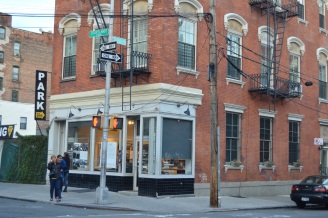By Michael Dobuski

The Bronx Documentary Center features an exhibit about emigration from the Bronx. Michael Dobuski/ The Fordham Ram.
In 2011, the United States was responsible for the deportation of over 400,000 migrants, according to a new exhibit at the Bronx Documentary Center in the South Bronx named “Via PanAm: The Pursuit of Happiness.” The Documentary Center is a remarkably simple space located in a storefront of an old building on the corner of 149th Street and Cortland Avenue. It is advertised to the outside world by only some modest lettering on the windows detailing the center’s name and hours. The atmosphere is cozy with its unvarnished floors and ornate, if slightly out-of-place, wooden columns. The exhibit is relatively small and personal, only filling the one room the venue has for displays. Kadir Van Lohuizen, the exhibit’s creator, said that he hopes the photographs included in the exhibit reflect the complexities of the migrant experience, whether those experiences come from the tundras of northern Alaska, the island region of Guna Yala in Panama or the neglected reservations of the Canadian First Nations people. It also features a video that, while I was there, was playing a piece about armed conflicts in Columbia to an audience of empty folding chairs. “Via PanAm” mixes stark black and white photography with pictures full of saturated color, and is a combination of landscapes, staged shots and candid moments. Intentional or not, the exhibit and the venue in which it is displayed parallel the surrounding community. Despite several convincing signs of turnaround, the South Bronx is still one of the poorest neighborhoods in New York City and the United States, with one in two residents living below the poverty line. The NYPD considers the precincts within the South Bronx to be major “impact zones,” given the high rate of violent crime, gang activity and prostitution. But you knew that. What might be less well-known is how the area became what it is today.
By the end of the Second World War, the Jewish population in the Bronx had grown to such a degree that they accounted for nearly half the residents in the borough: the largest demographic in the region by far. However, the 1960s brought one of the largest resettlements that New York City has ever seen, with over 500,000 of the original 600,000 Jewish residents moving away from the Bronx in favor of greener suburbs like Westchester or Rockland, New York. The borough’s 700 synagogues dwindled to just 34. The reason for this “white flight,” as the migration was dubbed by the newspapers at the time, is difficult to narrow down.
Factors such as the deteriorating quality of homes, racial change brought on by the erection of various public housing communities and a discriminatory public attitude in addition to federal money being funneled into ill-fated construction projects rather than to the emerging drug-related street crime problem all culminated in the Bronx’s housing crisis of the 1970s. New York City itself almost went bankrupt. However, to look at the history of the South Bronx solely through the lens of its economic troubles is to miss the point.
The second half of the 20th century also saw an influx of people moving to the South Bronx, who brought with them their own food, music and sense of community. It was during this time that R&B and doo-wop music were formed, which influenced the creation of hip-hop, rap and American salsa. Artists, politicians, scientists and writers of all kinds saw their origins in the Bronx during this time, as well as a small, but important population of photographers.
While the Bronx Documentary Center’s latest exhibition shows the plight of migrants around the world to those within the Bronx, an online photography project called “Faces of Addiction” shows the struggle of the Bronx’s most troubled citizens to those from around the world. The project’s photographer Christopher Arnade began his career at Johns Hopkins in 1992, where he received his PhD in physics. He then spent the next 20 years of his life as a Wall Street trader until, in 2012, he quit his job in favor of his passion: photography. Arnade’s “Faces of Addiction” series highlights the hardships faced by those living in Hunt’s Point, the poorest neighborhood in New York City. It is located in the South Bronx.
Arnade’s pictures tell the stories of its residents from a recovered heroin addict helping his friend through the same excruciating process to frustrated workers fed up with living at the ragged edge of society. Perhaps his most moving character is Beauty, a prostitute from Oklahoma who lived in the Bronx and is now a prisoner on Rikers Island. “Faces of Addiction” is grittier and less kitschy than its natural comparison, Humans of New York, and consists of over 250 individual photos. Arnade has since undertaken similar projects in other parts of the country. Both the Bronx Documentary Center and “Faces of Addiction” serve to underline the far reaching influence of migration, which is an issue more relevant now than ever. It is also a large part of what makes the Bronx the place it is today.
“Via PanAm” is free to visit and runs until Dec. 13.
